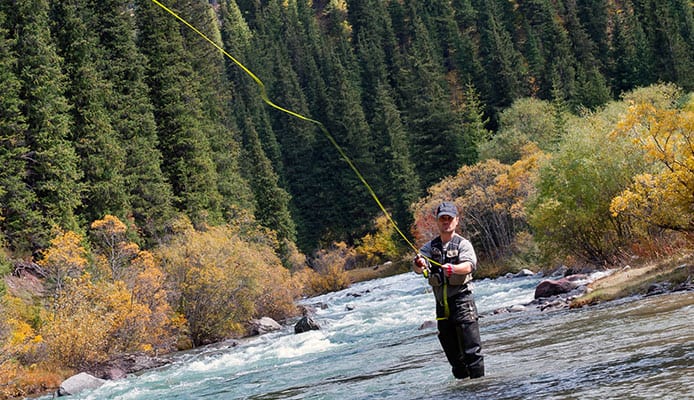
People who are just getting started with fishing mostly start out using a standard spinning reel and rod. This is because this is one of the easiest setups to use and is effective in a variety of fishing conditions. Despite that, there is still some learning curve involved when it comes to learning how to cast a spinning reel. Don’t worry though because it isn’t that difficult at all as can be seen below.
1. Collect Your Gear
Before anything else, you first need to set up your fishing gear. To do that, you’ll need the following:
- Spinning Reel. If you’re still going to buy your spinning reel, you’ll want to do some research first to make sure that you’re getting one that will suit your needs best. Spinning reels come in different sizes, and to avoid confusion you’ll want to settle for the size that you will be using the most.
- Spinning Rod. Fishing rods come in a wide variety, but you’ll want to be specific and ask for a spinning rod as these are specifically designed to go with spinning reels. They are also available in various lengths, so again you’ll want to settle for the length that you’ll be using the most.
- Fishing Line. The kind of fishing line that you’ll need will depend on the kind of fish that you are targeting. There are various types of fishing lines available, though you may want to get yourself a monofilament fishing line for now.
- Bait/Lures or practice plug. There are plenty of baits and lures that you can use with a spinning tackle, and your choice will again be influenced by the type of fish that you’re after. For practice, you should consider using a practice plug first.
2. Assemble your Gear
Once you have all your gear ready, it’s time to set up your spinning tackle. To do this, follow the steps outlined below.
- Attach the spinning reel to the spinning rod by loosening the reel seat on the rod. Check that the reel seat is big enough to accommodate the reel’s foot. After that, place the reel foot into the reel seat and tighten it. Try moving the reel sideways and check if it’s wobbling. If it is, remove the reel from the rod and re-attach it until the reel is fixed securely into the rod.
- Spool the spinning reel with a fishing line of your choice by opening the bail and placing the line around the reel. Use a standard knot or an overhand knot when tying the line to the reel. Afterward, close the bail and turn the reel until you have the desired amount of line on the reel. Just how much line you’ll need will depend on the size of your spinning reel and the line you’re using. You can also check the line capacity indicated on the reel’s side or packaging.
- String the rod by grabbing the tip of the line with one hand and opening the bail arm with the other hand. Afterward, place the line through each of the rod guides starting from the bottommost guide and working your way to the end guide at the tip. Be careful not to let go of the line; otherwise, it may fall back through the guides.
3. Use a Practice Plug
As mentioned earlier, you may want to start practicing how to cast a spinning reel and rod using a practice plug first which you can do in your backyard or the driveway. The reason why you shouldn’t use your lure at this point is that you don’t want to damage them as they hit the ground. Also, hooks may get snagged in the trees or bushes in your backyard and driveway. Practice plugs are also a great way for you to practice tying your knots.
4. Set the Drag
The drag mechanism on a spinning reel is located either on the top of the reel (which is also referred to as a front drag spinning reel) or on the back end of the reel (also referred to as a rear drag spinning reel). This mechanism allows you to set how much resistance the fish will feel as it pulls on the line, and the tighter the drag is set, the more resistance the fish will feel.
There are two common ways that anglers use when setting the drag. The first one is with the use of a scale, either a fishing spring scale or a fishing digital scale. This method is considered to be a more accurate method of the two. The second method is setting the drag by ‘feel’ or without the aid of another instrument such as a scale. Many anglers do this, though it can take a whole lot of experience and knowledge before can get the ‘feel’ right. That said, beginning anglers are advised to utilize the first method when setting the drag on their spinning rods.
Aside from knowing how to set the drag, it is also important that you know how to determine the correct drag setting for your spinning tackle. Accordingly, the drag should be set to 25% of your fishing line’s pound test. You can find your fishing line’s pound test on the label or packaging it came it. That said, if your line’s pound test is 8 lbs. then the correct drag setting would be at 2 lbs.
5. Hold the Rod Properly
Knowing how to hold a spinning rod properly is crucial to a successful cast. There are two ways of holding a spinning rod.
Foot in between Fingers
The most common and traditional way of holding a spinning rod is the foot-in-between-fingers method. As the name suggests, here you’ll be holding the rod with the foot of the spinning reel in between your fingers, usually between the middle and ring finger. However, some prefer to place the foot between other fingers like between the index and middle finger.
Fingers Forward Method
In this method, all your fingers are positioned in front of the spinning reel’s foot. This method allows you to have a full and fist-like grip on the rod, which accordingly is the strongest and most natural grip. Some anglers use this method as it appears to be more comfortable than the foot-in-between-fingers method. It also gives them more power in manipulating the rod when muscling a fish.
6. Reel out the Line
Next, reel in (or out as the case may be) your fishing line by turning the handle slowly until you have at least six inches of line dangling from the tip of your fishing rod. Some anglers will say that you can reel out up to twelve inches of the line if that feels more natural for you.
7. Prepare to Cast
Once you have reeled the desired length for your line at the end of your rod, grab the line with the crook of your rod hand’s index finger and press it against the rod’s handle. Using your other hand, open the bail on the spinning reel.
You might also like: Perfect Saltwater Fishing Rods
8. Casting Your Rod
Afterward, align your spinning rod so that it is parallel to the ground and then point it towards your target. Then, in one smooth motion bring the rod up until it is almost vertical to the ground. Allow the tip to flex or bend a little as it goes up and push it forward without pausing. An important note to remember is that all the rod’s movement should be manipulated by your hands and not your shoulders.
When the rod (from the vertical position or 12 o’clock position), goes to the 2 o’clock position let go of the line you have tucked in your rod hand’s index finger. This will send the line and lure flying from your spinning rod, and hopefully towards your target. This is probably the most challenging part of the cast, and many beginning anglers usually have trouble when it comes to finding the correct timing for releasing their index fingers. However, this is nothing that practice and experience can’t cure.
One problem that many beginning anglers encounter at this point is that their lures or practice plug goes straight up into the air, which usually happens when you release the line too early. Another problem is having the lure or plug come crashing at their feet, which happens when the line is released too late.
9. Reel in the Line
To reel in the line, close the bail first and then place the line in the roller. Then, turn the handle to pull the line back towards you. Anglers have their own styles when it comes to reeling in their lines. Some do it slowly and carefully, while others do it rather quickly. Others reel in their lines at a constant speed while others jerk the bait in at fast and slow intervals. All these methods are actually effective in their own rights, and you’ll want to find the most effective method which works for your fishing style and requirements.
10. Keep Practicing
Reading about how to cast or how to use a spinning reel can only get you so far. Thus, after reading and studying, you still need to get out there and start practicing. Only with actual practice (and patience) will you be able to learn how to cast a spinning rod easily and perfect your casting technique.
Globo Surf Overview
Learning how to cast a spinning reel and rod isn’t that difficult provided you’re willing to put in the time and effort required. It may take you several attempts to get it right, but all these will be worth it when you see your lures landing on your target areas.


